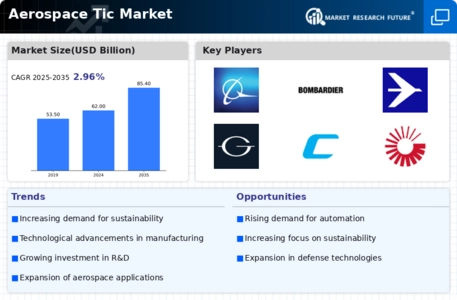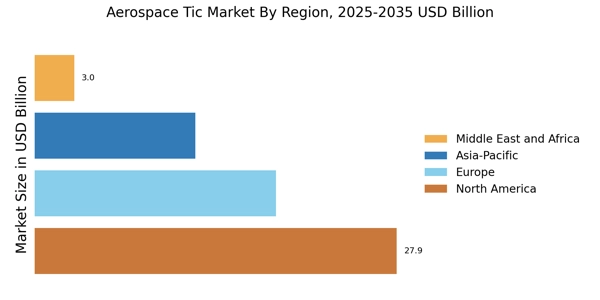Increased Defense Spending
The Aerospace Tic Market is experiencing a notable surge in defense spending across various nations. Governments are prioritizing the modernization of their military capabilities, which includes the procurement of advanced aerospace technologies. For instance, the defense budgets of several countries have seen increases of approximately 5 to 10% annually, reflecting a commitment to enhancing national security. This trend is likely to drive demand for aerospace TIC solutions, as military applications require stringent compliance with safety and performance standards. Consequently, the Aerospace Tic Market is poised to benefit from this heightened focus on defense, as companies innovate to meet the evolving needs of military clients.
Growing Commercial Aviation Demand
The Aerospace Tic Market is witnessing a robust growth trajectory fueled by the increasing demand for commercial aviation. With air travel projected to grow at a rate of around 4 to 5% annually, airlines are investing in new aircraft and retrofitting existing fleets to enhance efficiency and passenger experience. This trend necessitates advanced TIC solutions to ensure compliance with international safety regulations and operational standards. As airlines expand their operations, the Aerospace Tic Market is likely to see a corresponding rise in demand for testing, inspection, and certification services, which are critical for maintaining safety and reliability in commercial aviation.
Emergence of Electric and Hybrid Aircraft
The Aerospace Tic Market is on the cusp of transformation with the emergence of electric and hybrid aircraft technologies. As environmental concerns gain prominence, manufacturers are increasingly exploring sustainable aviation solutions. The market for electric aircraft is projected to grow significantly, with estimates suggesting a compound annual growth rate of over 20% in the coming years. This shift towards greener technologies necessitates specialized TIC services to ensure that these innovative aircraft meet safety and performance standards. The Aerospace Tic Market is likely to adapt to these changes, providing essential support for the development and certification of electric and hybrid aircraft.
Regulatory Compliance and Safety Standards
The Aerospace Tic Market is heavily influenced by stringent regulatory compliance and safety standards. Regulatory bodies are continuously updating guidelines to enhance safety in aerospace operations, which in turn drives demand for TIC services. Companies operating in this sector must adhere to rigorous testing and certification processes to ensure their products meet the required safety benchmarks. The increasing complexity of aerospace systems further emphasizes the need for comprehensive TIC solutions. As regulations evolve, the Aerospace Tic Market is expected to expand, providing essential services that help manufacturers navigate the intricate landscape of compliance and safety.
Technological Integration in Aerospace Systems
The Aerospace Tic Market is experiencing a paradigm shift due to the integration of advanced technologies in aerospace systems. Innovations such as artificial intelligence, big data analytics, and the Internet of Things are revolutionizing the way aerospace operations are conducted. These technologies enhance efficiency, reduce operational costs, and improve safety outcomes. As aerospace companies adopt these advancements, the demand for TIC services that can validate and certify these technologies becomes paramount. The Aerospace Tic Market is likely to evolve in response to these technological trends, offering specialized services that ensure the reliability and safety of integrated aerospace systems.


















Leave a Comment